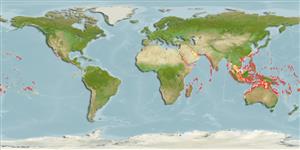>
Gobiiformes (Gobies) >
Gobiidae (Gobies) > Gobionellinae
Etymology: Gnatholepis: Greek, gnathos = jaw + Greek,lepis = scale (Ref. 45335); cauerensis: Named for the southern location of the islands in southeastern Oceania where the species is found..
More on author: Bleeker.
Environment: milieu / climate zone / depth range / distribution range
นิเวศวิทยา
เกี่ยวกับทะเล,น้ำเค็ม; กร่อย เกี่ยวกับหินโสโครก; ระดับความลึก 2 - 50 m (Ref. 90102), usually 2 - 20 m (Ref. 27115). Tropical; 30°N - 28°S
Indo-Pacific: widespread from South Africa to Pitcairn I.; in the Pacific north to Miyake-jima, Japan, south to Sydney Harbour, Australia; in the Indian Ocean north to Djibouti (Gulf of Tadjourah) and south to Aliwal Shoal, Kwa-Zulu Natal.
ขนาด / น้ำหนัก / Age
Maturity: Lm ? range ? - ? cm
Max length : 6.0 cm SL เพศผู้/กระเทย; (Ref. 48637)
เงี่ยงครีบหลัง (รวม): 7; ก้านครีบอ่อนที่หาง (รวม): 11; เงี่ยงครีบก้น 1; ก้านครีบอ่อนที่ก้น: 11. Distinguished by the following characteristics: moderate-sized (up to 56 mm SL) with wide range in live colour pattern; ctenoid body scales usually reaching rear corner of opercle, occasionally ctenoid scales reaching to above rear preopercular margin; nape midline scales always cycloid, distinct flap present at end of lower lip; when alive, colour variable: body translucent white with five to seven rows of small variably coloured (dull orange, brown, red-brown to blackish) spots and/or thin lines and about six indistinct diffuse orange-brown to purple-brown blotches along midside; narrow vertical black mark on top of each eye, marks may join each other across interorbital space, and narrow black vertical line crossing cheek below eye; small dark mark of variable shape (often W-shaped) above pectoral fin base, with small yellow spot in centre; second dorsal and anal fin rays usually I,11; pectoral rays 12-18, modally 16; lateral scales 24-30, modally 27; 7-12 predorsal scales (modally 9) (Ref. 92171).
A common species that occurs in sheltered sandy areas from reef flats to seaward reefs; over sandy bottoms near pieces of rubble, rock, or coral (live or dead) (Ref. 9710, 48637, 92171). Solitary or in small groups (Ref. 90102). Feeds on algae, detritus and small benthic invertebrates (Ref. 89972).
Life cycle and mating behavior
วัยเจริญพันธุ์ | การสืบพันธุ์ | การวางไข่ | เซลสืบพันธ์ของเพศเมีย(ไข่) | ความดกของไข่ | ตัวอ่อน
Larson, H.K. and D.J. Buckle, 2012. A revision of the goby genus Gnatholepis Bleeker (Teleostei, Gobiidae, Gobionellinae), with description of a new species. Zootaxa 3529:1-69. (Ref. 92171)
IUCN Red List Status (Ref. 130435)
Threat to humans
Harmless
Human uses
สถานที่แสดงสัตว์และพืชน้ำ: การค้า
ข้อมูลเพิ่มเติม
ชื่อสามัญชื่อพ้องกลไกการเผาผลาญพลังงานผู้ล่าการศึกษาเกี่ยวกับผลกระทบของสารประกอบทางเคมีที่เป็นอันตรายต่อสิ่งมีชีวิต ประชากร และสิ่งแวดล้อมการสืบพันธุ์วัยเจริญพันธุ์การวางไข่การรวมกลุ่มวางไข่ความดกของไข่เซลสืบพันธ์ของเพศเมีย(ไข่)Egg development
อ้างอิงการเพาะเลี้ยงสัตว์น้ำประวัติการเพาะเลี้ยงสัตว์น้ำสายพันธุ์พันธุศาสตร์ElectrophoresesอัตราพันธุกรรมโรคการแปรรูปNutrientsMass conversion
เครื่องมือ
Special reports
Download XML
แหล่งที่มาจากอินเตอร์เน็ต
Estimates based on models
Preferred temperature (Ref.
123201): 24.7 - 28.9, mean 27.6 °C (based on 774 cells).
Phylogenetic diversity index (Ref.
82804): PD
50 = 0.5010 [Uniqueness, from 0.5 = low to 2.0 = high].
Bayesian length-weight: a=0.00977 (0.00442 - 0.02163), b=3.05 (2.86 - 3.24), in cm total length, based on LWR estimates for this (Sub)family-body shape (Ref.
93245).
ระดับชั้นอาหาร (Ref.
69278): 2.3 ±0.0 se; based on diet studies.
ความสามารถในการกลับคืนสู่ปกติ (Ref.
120179): ความสูง, เวลาต่ำสุดที่จะทำให้ประชากรเพิ่มขึ้นเป็น 2 เท่าใช้เวลาน้อยกว่า 15 เดือน (Preliminary K or Fecundity.).
Fishing Vulnerability (Ref.
59153): Low vulnerability (10 of 100).
Nutrients (Ref.
124155): Calcium = 173 [83, 398] mg/100g; Iron = 1.01 [0.47, 1.99] mg/100g; Protein = 18.2 [16.2, 19.9] %; Omega3 = 0.164 [0.069, 0.322] g/100g; Selenium = 23.8 [11.4, 62.9] μg/100g; VitaminA = 122 [29, 448] μg/100g; Zinc = 3.25 [2.10, 4.97] mg/100g (wet weight);
